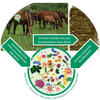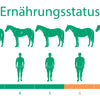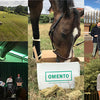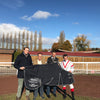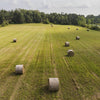Health trap of obesity – the correct Body Mass Index (BMI) of the horse
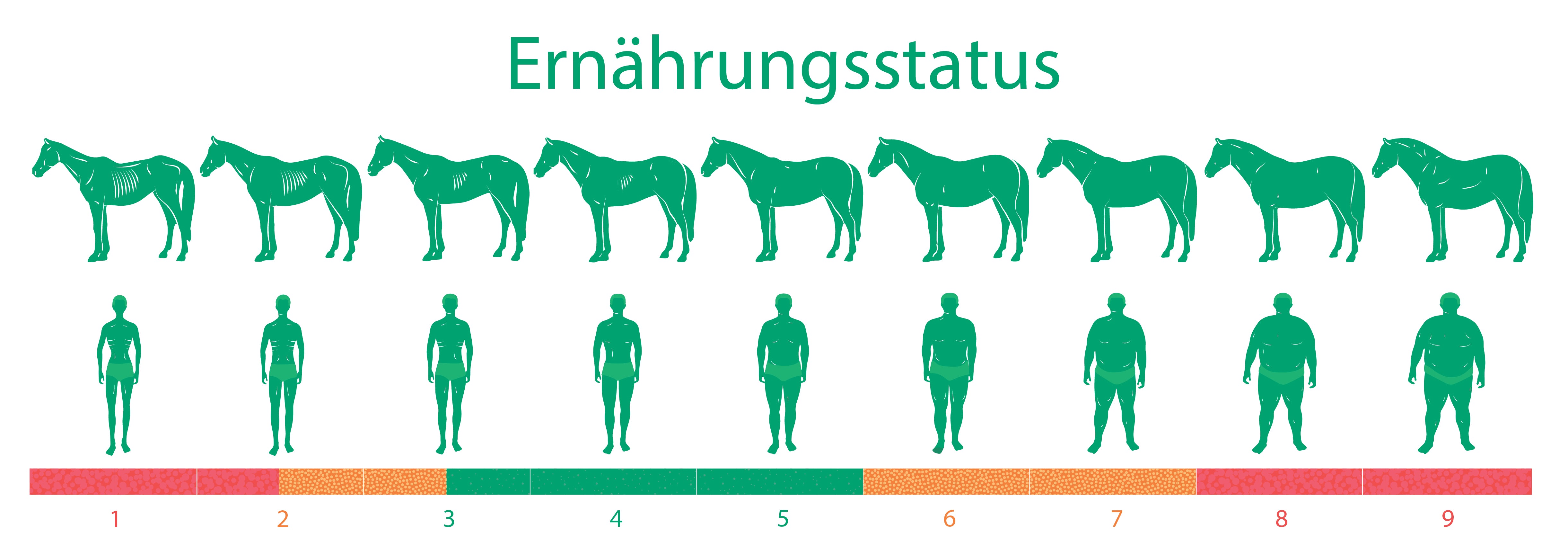
Definition of obesity (from the Latin “adeps” = fat): Exceeding the ideal weight by more than 20 percent.
Grazing for hours on rich pastures, plenty of straw, lots of concentrated feed and sugary supplements and treats with too little exercise: the figure trap can also affect our horses. What is seen as "cushioning for bad times" or, even worse, "muscle mass" is a serious health problem. Just like with humans, too much weight on the ribs can lead to physical problems. Joints, tendons and ligaments are permanently overloaded by the excess weight. The risk of circulatory problems, metabolic disorders and organ diseases increases. The skin, coat and mental state of the fat animal can also suffer.
The correct figure of a horse is not determined by the number of kilos on a scale, although the weight (e.g. measured on a mobile horse scale) can give a certain indication. Much more important for checking the figure is the visual and tactile impression: are the ribs easy to feel or are they hidden under a thick layer of fat, is the belly huge or does it show a typical depression on the flank, do the pelvic bones or spine protrude alarmingly, can wobbly fat pads be seen or felt on the crest of the mane or tail? The ideal weight of a horse can therefore be judged primarily by externally visible and tangible parameters, as the graph of the horse's Body Mass Index (BMI) in comparison to humans clearly shows. The ideal measurement lies - as is so often the case - in the happy medium. A healthy BMI corresponds to a value of 4 or 5. Depending on the breed, a BMI of 3 can still be in the green zone, because thoroughbreds or horses with a high "blood content" tend to have a slimmer figure without this necessarily being a health concern. All areas outside of the ideal BMI values are associated with risks for the horse's health - this applies to animals that are too fat as well as too thin.

If the animal carries too much weight around with it for a long time, ligaments, tendons and joints are put under excessive strain, which can cause chronic damage such as arthritis. The risk of high blood pressure and organ diseases, as well as various metabolic disorders, also increases. The excess fat also causes unsightly damage to the skin and fur due to the increased accumulation of fat. Ugly thick skin calluses and dull fur without any shine are classic symptoms of an overweight four-legged friend. In addition to the medical aspects, the animal's quality of life is also reduced. The mobility, condition and freedom of the fat four-legged friend are extremely limited, which causes mental torment, especially for an active animal like the horse.
The art of feeding correctly without causing obesity lies in the balance between energy intake and energy consumption. The horse's need for constant roughage intake (need to chew + activity) must be met by providing it with sufficient hay and straw. At the same time, the concentrated feed intake must be adjusted to the actual training workload. For roughage portions, hay from the 2nd or 3rd cut is therefore suitable for pug horses, as it contains significantly less energy than the first cut. This hay can be mixed with feed straw to lower the energy level even further. If the horse is put out to pasture, grazed pastures are the only option, as fresh, long grass is pure energy.
A fine-meshed hay net can help to keep the horse sufficiently occupied in the box, as this allows the horse to nibble for a long time without gulping down too much. If the horses are ravenously keen to pounce on the fresh bedding, switching to shavings can help prevent constipation or colic. If the horse is acutely overweight, the concentrated feed must also be drastically reduced and high-calorie supplements such as oil or fatty additives must be avoided. In order to avoid vitamin or mineral deficiencies, the feed may need to be supplemented with ready-made vitamin mixtures.
OMENTO helps to keep the horse's stomach and perineum in balance and also extends the natural feeding times. This means that the concentrated feed is chewed for longer, more saliva is produced and feed utilization is optimized. Thanks to its purely natural composition, it offers the horse all essential nutrients without putting a strain on the organism. For horses that need less energy, OMENTO Zero offers an oat-free alternative.
Most OMENTO products are free of sugar and sugar substitutes. Sugar products in particular cause metabolic problems, which can lead to overweight and obesity.
In contrast to many types of hay, all OMENTO products contain a wide variety of different types of grass in order to provide the horse with all natural nutrients and fiber. Natural nutrients are characterized by particularly good bioavailability. They also provide secondary plant substances, vitamin precursors and co-factors. By embedding them in this natural environment, the nutrients can be utilized particularly well. The natural supply of easily digestible crude fiber through the diverse grasses contained keeps the gastrointestinal flora and digestion in balance, which enables even feed utilization without the occurrence of so-called blood sugar peaks.
In addition to appropriate feeding, the right exercise program is crucial. The principle here is: as much as possible, but increase slowly! The horse should be out of the box for at least two hours every day. Ideally longer. Intensive training days, interval training, long rides, daily walks in the horse walker, long hours in the paddock. Any opportunity for exercise is good for the horse. Individual excessive riding hours, only to then have a rest day, are fatal. This can be dangerous, especially for fat horses, because in addition to painful muscle soreness, there is also a risk of life-threatening colic.
Other consequences of obesity:
laminitis
Laminitis in horses is a disease caused by impaired blood circulation and subsequent inflammation of the hoof capsule with water retention. Laminitis is "traditionally" considered a feed-related disease. In addition to the fructans, which are mainly found in fresh grass, excessive amounts of carbohydrates and excess weight are considered to promote laminitis.
liver and kidney diseases
A lot of weight, a lot of energy, a lot of protein – in overweight animals, the liver and kidneys are overstressed. Overtaxed organs are susceptible to infections, insufficiencies and chronic diseases.
Equine metabolic syndrome
A pathological disruption of the horse's metabolism, known as EMS for short, results in incorrect utilization of energy and sugar. The result is an accumulation of significant fat deposits and an increase in blood sugar levels. In extreme cases, the sugar can no longer be absorbed into the cells and a special form of diabetes with insulin resistance develops.
The most important prerequisite for a healthy BMI is a healthy, species-appropriate and adapted diet that covers the horse's daily needs and does not burden the metabolism with unhealthy additives. In addition to high quality feed, the key factors for healthy feeding of the horse are the ration design and feeding management. The horse, originally a steppe animal, is being artificially kept in stables and is being fed a diet that no longer has much in common with its original nutritional intake.
The aim of feeding and keeping the horse should be to encourage it to chew for as long as possible. This can be helped by providing free access to hay, adding high-fiber supplements or complete feed, and allowing the horse to graze for a sufficiently long time. This effectively prevents digestive problems and keeps the horse active and fit. Sugar and low-quality treats should be avoided entirely.
Dr. med. vet. Hanna Stephan
After studying veterinary medicine at the Veterinary School in Hanover, Hanna Katrin Stephan specialized in the nutrition of horses and dogs and is currently completing her doctorate in this field at the LMU in Munich. She is a product developer and consultant for dog and horse feed products and also a specialist author in this field. Her greatest passion, besides her own animals, is show jumping, in which she has already successfully competed up to the advanced level.

